
Bible Teaching About the Triune GodWhat is meant by the
Trinity? Trinity means “three in one” or “tri-unity.” According to the Trinity
teaching, God is one, while existing as three beings or entities. In other words, God is uniplural, perhaps
like a family or company. There is unity, but also plurality. The Hebrew word for
God, Elohim denotes more
than one being and is connected with the pronoun “us”, for example, at Creation, after the Fall, and at the
Tower of Babel. (See Genesis 1:26; 3:22; 11:7.)Although the word Trinity is not found in the Bible, the concept combines two clear teachings. First, there is one God – the Creator and Redeemer alone is God. Only he is the life-giver and sustainer of all there is. He is over all, through all, and in all. No other gods are to be served or worshipped, for in reality they are not gods. Secondly, three distinct beings are referred to in the Scriptures as God – God the Father, God’s Son, Jesus Christ, and the Holy Spirit. (See Exodus 20:3; Deuteronomy 4:35, 39; 6:4; Nehemiah 9:6; Isaiah 43:10-11; 44:6; Matthew 12:31-32; John 10:20; 20:28-31; Acts 5:3-4, 9; Romans 3:29-30; 1 Corinthians 8:4-6; Galatians 3:20; Ephesians 4:6; Colossians 2:9.) The fact that God the Father, Jesus Christ, and the Holy Spirit are each mentioned separately, as well as simultaneously shows that they are distinct entities or persons. For example, all three beings were involved in the creation of the universe. God made all things by Jesus Christ, and the Spirit of God is pictured as “hovering over the face of the waters.” When Jesus was baptized, the Father affirmed his love for the Son, and the Holy Spirit descended on him as a dove. Later, the Son prayed and gave thanks to the Father, and then fed thousands with a few loaves and fish. On another occasion after a short prayer to the Father, he raised a person from the dead. Upon his ascension to heaven, the Son would ask the Father to send the Holy Spirit to the earth to empower his followers. (See Genesis 1:2; Matthew 3:13-17; 14:17-21; John 11:38-44; 14:16-18; John 15:26; Colossians 1:16.) Each member of the Trinity has special functions. For example, God the Father planned salvation before the world was created. At the right time, the Holy Spirit conceived the Son inside a virgin so that he could be born as a human. The Son gave his life on the cross as a sacrifice for human sin. The Father raised the Son from death to life and appointed him as a merciful High Priest. God the Father draws believers to the Son and the Holy Spirit brings the Father and Son into their lives. (See Matthew 1:20-23; John 6:44; 14:17, 23; 16:13-15; 17:24; 1 Corinthians 15:1-6; 2 Timothy 1:9; Titus 1:1-3; 3:5-7; Hebrews 2:17; 4:15; 1 Peter 1:18-23.) How can the Trinity be illustrated to better understand
it?
While the Trinity is one of the Christian
mysteries, some analogies from life may be suggested. The most helpful analogies retain the unity of God while
showing a simultaneous plurality. Some analogies are helpful as far as showing the nature of the mutual
relationships in the triune Godhead. Why is
the teaching of the Trinity important?
|


Photos:
MS Office Clipart
|
Seeking the |
For the mobile site, click http://truth-and-beauty.org/mobile
See also my husband's site http://www.spirituality-for-life.org
Web design: Eva Peck (using XSitePro site
builder)
Photos: Alexander
Peck (unless otherwise noted)
© 2009 and beyond -- All Rights Reserved
Website hosting: VodaHost (unlimited websites and domains at low cost)
Last
updated: January 9, 2015

 Facebook
Facebook Twitter
Twitter Digg
Digg Stumbleupon
Stumbleupon